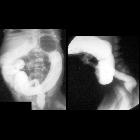currarino triad









The Currarino syndrome is a complex condition variably comprised of characteristic congenital anomalies of the sacrum, anorectum and presacral soft tissues. It is also known as the Currarino triad or ASP triad, however, not all three features are always present .
- anorectal malformation or congenital anorectal stenosis
- sacrococcygeal osseous defect (always present)
- classically, hemisacrum with intact first sacral vertebra ("sickle-shaped sacrum")
- mild (hypoplasia) to severe (agenesis) of sacrum and coccyx
- presacral mass (various types)
- anterior sacral meningocele (most common)
- tumor, e.g. mature teratoma (common)
- dermoid/epidermoid cyst (rare)
Terminology
The triad of features gives rise to the acronym ASP triad (anorectal malformation, sacrococcygeal defect, presacral mass) . Since the condition was initially defined as a set of radiographic findings, it was considered an association (like VACTERL).
Subsequent investigation has shown a genetic basis with specific familial inheritance pattern, as well as a variety of other associated congenital anomalies, thus the terminology "Currarino syndrome" is considered more appropriate .
Epidemiology
Although the condition may be detected and diagnosed antenatally or peripartum, it is not typically diagnosed after the first month of life.
Pathology
The condition is associated with a mutation of the MNX1 (previously HLXB9) gene . The mutation is inherited in an autosomal dominant with reduced penetrance and variable expressivity .
History and etymology
It was originally described by Italian-born pediatric radiologist Guido Currarino (1920-2015) in 1981 . He was a charter member of Society of Pediatric Radiology and interested in congenital abnormalities.
The Currarino triad should not be confused with Currarino-Silverman syndrome, a pectus carinatum type 2 deformity which is partially named after the same radiologist.
Siehe auch:
- präsakrale Tumoren
- Analatresie
- Morbus Hirschsprung
- epidermale Inklusionszyste
- sacral agenesis
- Schwanzdarmzyste
- kindlicher präsakraler Tumor
- anteriore sakrale Meningozele
- Currarino's classification of anomalies of posterior arch of atlas
- sakrale Fehlbildungen
- anorektale Stenosen
und weiter:

 Assoziationen und Differentialdiagnosen zu ASP-Assoziation:
Assoziationen und Differentialdiagnosen zu ASP-Assoziation:






